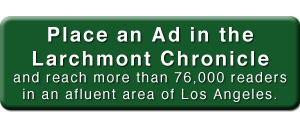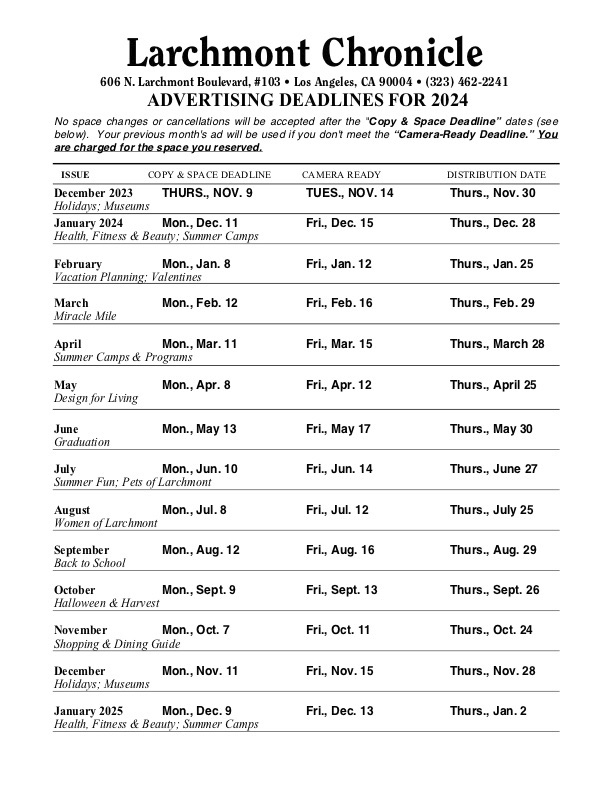Wilshire Country Club, organized near tar fields in the ‘wilderness’ by local businessmen in 1919, celebrates 100th
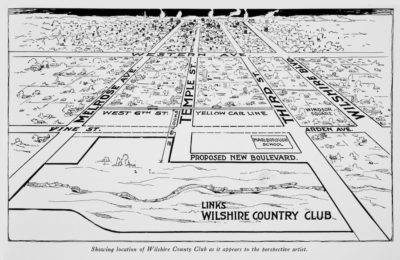
1919 PROSPECTUS for potential members shows the new club’s location (looking east). Marlborough School had moved to Third Street three years earlier.
Last month, in the first installment of our three-part series, we noted the prominent role played by women in the history of Wilshire Country Club. The following describes the founding years and early growth of the club. The October issue will report on more recent history plus the centennial celebration events taking place at the end of this month.
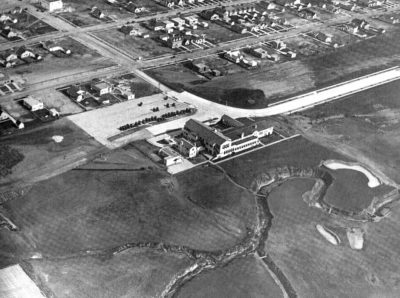
AN AERIAL VIEW shows Wilshire Country Club, circa 1920.
Before it was a lush golf course, the land that is now home to the Wilshire Country Club was part of an oil field owned by G. Allan Hancock. Before that, it belonged to his father, Henry Hancock, who made a small fortune by developing the nearby tar pits. And before that, the land passed from the Native Americans to the Spanish and Mexican governments as land up and down California was confiscated and settled.
Mexican land grant
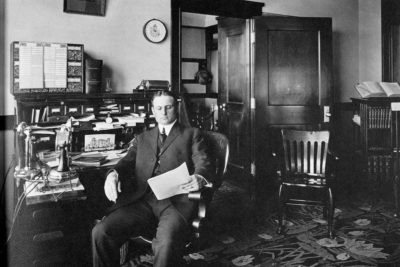
ORIGINAL BOARD MEMBER G. Allan Hancock agreed to the idea of a golf course on the land he owned in the Los Angeles Wilshire District.
In 1828, José Antonio Carrillo, the Alcalde (mayor) of Los Angeles, granted Rancho La Brea to Antonio José Rocha. When the Mexican-American War ended in 1848 and California was ceded to the United States, the Treaty of Guadalupe Hidalgo ensured that land grants given before the war would be protected. When, however, the Rocha family filed their claim to Rancho La Brea, it was rejected by the Public Land Commission established in California in 1851 to adjudicate the validity of Spanish and Mexican land grants. A legal battle followed, and the Rocha claim was championed by surveyor and lawyer Henry Hancock. They eventually established their title to the land, but legal expenses left the Rochas broke, and they deeded the land to Hancock for $2.50 an acre.
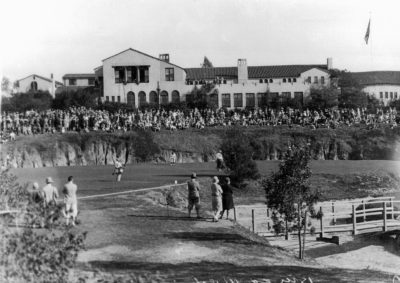
WILSHIRE COUNTRY CLUB WAS HOST of the 1928 Los Angeles Open.
There, Hancock found success developing the asphalt deposits on the land. When he died, the land passed to his wife, and then to his son, G. Allan, the man responsible for subdividing and developing the land. He based his oil company, the Rancho La Brea Oil Company, here. A few years later, in 1919, the land’s tar deposits made the oil unprofitable. Thus, when a small group of businessmen approached Hancock with the desire to construct a golf course on the land, Hancock agreed. He initially rented them the land for $1,650 for the first two years.
Around this time, Hancock also donated 23 acres of Rancho La Brea to Los Angeles County for the excavation and preservation of the fossils found in the tar deposits. To this day, the La Brea Tar Pits is still excavating fossils onsite.
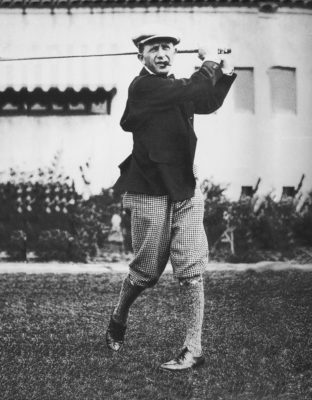
BING CROSBY played at Wilshire in the early 1930s before his film career took off.
Back to the golf course: The men who approached Hancock with a vision went on to found Wilshire Country Club. It may owe its name, “Country Club,” to the fact that, at that point, Rancho La Brea was undeveloped and practically wilderness, although it bordered the already-sprawling Hollywood.
The club was officially incorporated on Sept. 25, 1919. Groundbreaking quickly took place, led by the club’s architect, Norman Macbeth. His legacy can still be seen throughout the club, both in its designs and in the annual invitational tournament in his name, which remains one of the club’s most prestigious tournaments. In 1919, the organizer published ads for membership, offering them for $250 each, along with “special” memberships for women. Play began in December of 1920, and by then, the price of a regular membership had climbed to $1,000.
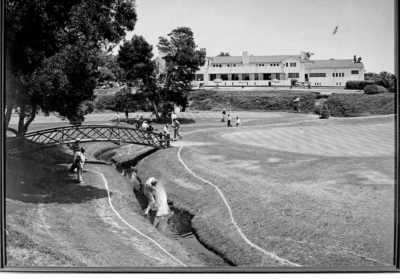
A MEMBER CHIPS OUT of the barranca on the 16th hole during the 1955 Macbeth tournament.
The heart of the club’s social activities, the clubhouse, was built at this time on the corner of Rossmore Avenue and Temple Street (now Beverly Boulevard), in a classic California Mission-style building which served the club for the next 50 years. Through funds raised from members, the club was able to buy the property from Hancock in 1925.
In its early years, the club hosted the Los Angeles Open four times: 1928, 1931, 1933, and 1944. At the 1944 Open, war rationing meant that golf balls were scarce, and instead of money, the prize was war bonds and food stamps.

THE ORIGINAL CLUBHOUSE was demolished in 1970.
Many of the visitors in the club’s early years were Hollywood stars and starlets. Howard Hughes played frequently in the ’20s and ’30s, entertaining professional ambitions for a time. Later, he and girlfriend Katherine Hepburn would often visit the course to play in secret. Their Muirfield Road home abutted the 8th green. Bob Hope also liked to visit the club, and he would often bring friends during his lunch break. One such friend was Bing Crosby who, during one visit, began practicing on the course. A member approached him to scold him, and after a heated argument, Crosby vowed never to return to the club. True to his word, he never did.
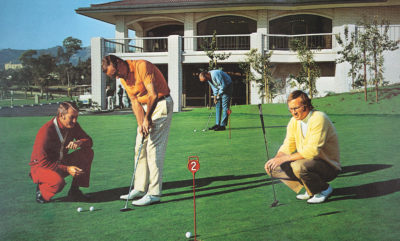
SECOND CLUBHOUSE (1971) is behind head golf professional Frank Morey (left), who shows members how to putt the ball.
Fast forward to 1971. After 50 years standing proudly on its corner, the clubhouse was due for a renovation. The members decided to tear it down entirely and build a new $2.16 million clubhouse designed by member architect and Fremont Place resident, Ragnar Qvale. However, the clubhouse you see today is the third clubhouse. It was designed by former Larchmont Village resident and architect Scott Johnson and was completed in 2001.
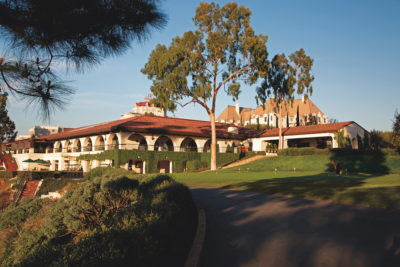
CURRENT CLUBHOUSE was completed in 2001 and remodeled in 2008.
Further remodeling of the clubhouse, again overseen by the Johnson Fain firm, was done in 2008, with an eye toward redesigning the building in conformance with Macbeth’s original vision for the property.
By Sidney Gubernick
Next Month
In the October issue, the Larchmont Chronicle will cover the club’s later years and its 2019 centennial celebration events.
Sidney Gubernick will be a sophomore at St. John’s College, Annapolis, Md. this fall. The Chronicle thanks WCC for the use of photographs from “The History of Wilshire Country Club: A Centennial Celebration,” written by club member Douglas N. Dickey.
Category: Real Estate

